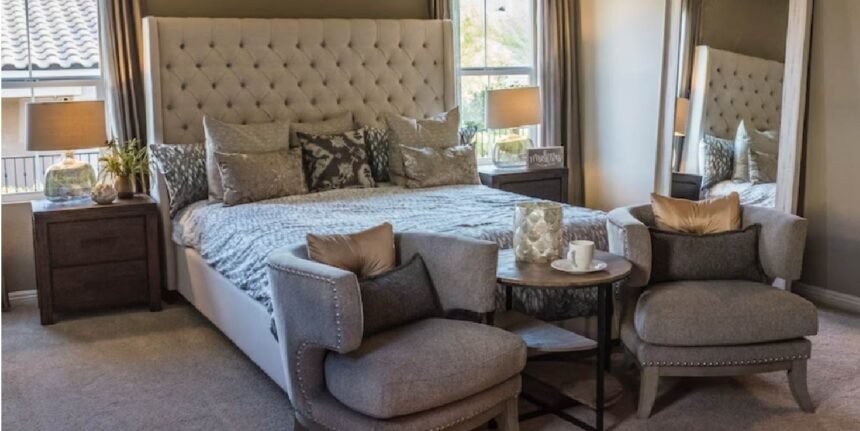For light sleepers, even the smallest disturbance—like a creaky floorboard, a flickering streetlight, or a distant car alarm—can mean hours of tossing and turning. A well-designed bedroom can make all the difference in creating a space that promotes uninterrupted rest. If you struggle with sleep disturbances, here are some essential design tips to transform your bedroom into a restful retreat.
1. Optimize Your Sleep Environment
The key to a peaceful night’s sleep is a bedroom environment that minimizes disruptions. Here’s how to set the foundation for better rest:
- Choose a Quiet Location: If possible, position your bedroom away from noisy areas, such as a busy street or the living room. If relocating isn’t an option, soundproofing can help (more on that below).
- Keep Electronics to a Minimum: Blue light from screens can interfere with melatonin production, making it harder to fall asleep. Avoid placing TVs, computers, and bright alarm clocks near your bed.
- Declutter Your Space: A messy bedroom can create subconscious stress and anxiety. Keep your sleeping area tidy and free of unnecessary distractions.
2. Invest in Soundproofing Solutions
For those who wake easily to noise, soundproofing is a must. Consider these options:
- Thick Curtains or Blackout Drapes: Not only do they block out light, but they also help dampen external noise.
- White Noise Machines or Fans: These create soothing background sounds that mask sudden noises.
- Acoustic Panels or Rugs: Installing wall panels or adding plush rugs and carpets can help absorb sound, reducing echoes and noise transmission.
- Weather Stripping for Doors and Windows: Gaps in doors and windows allow sound to seep in. Sealing them with weather stripping can make a big difference.
3. Choose a Sleep-Friendly Color Palette
The colors in your bedroom play a vital role in setting a restful mood. Opt for calming shades such as:
- Soft Blues and Greens: These colors are associated with tranquility and relaxation.
- Neutrals like Beige or Light Gray: These tones create a cozy and stress-free ambiance.
- Muted Pinks or Earthy Tones: Warmer, soft hues can also help foster a sense of calm without being too stimulating.
Avoid bright or bold colors like red, orange, or neon shades, which can be energizing rather than soothing.
4. Upgrade Your Bedding for Comfort
Since sleep is your goal, your bed should be as comfortable as possible. Here’s what to focus on:
- High-Quality Mattress: Choosing a mattress that aligns with your sleeping style—whether you sleep on your side, back, or stomach—can help prevent discomfort and restless nights. A King Plush mattress offers excellent support and luxurious comfort, while memory foam or hybrid options are ideal for absorbing movement, minimizing disturbances from a partner.
- Soft, Breathable Sheets: Opt for natural fabrics like cotton, bamboo, or linen to keep cool and comfortable.
- Pillows Suited to Your Sleeping Position: The right pillow can help align your spine and reduce tossing and turning. Side sleepers may benefit from firmer pillows, while back and stomach sleepers often prefer softer options.
5. Control Light Exposure
Light sensitivity is a common issue for light sleepers. Keep your bedroom dark with these strategies:
- Blackout Curtains: These block streetlights, early morning sun, and headlights from passing cars.
- Dimmer Switches or Warm Lighting: Bright white or blue-toned light can interfere with sleep. Use warm, dimmable lighting to create a soothing atmosphere.
- Eye Masks: A simple yet effective solution for those who are extra sensitive to light.
6. Maintain an Ideal Room Temperature
Temperature plays a huge role in sleep quality. The optimal sleeping temperature is typically between 60-67°F (15-19°C). To regulate your bedroom temperature:
- Use breathable bedding that keeps you cool in summer and warm in winter.
- Consider a ceiling fan or air purifier to improve air
- Try thermal curtains to keep outside heat or cold from affecting your room’s climate.
7. Introduce Relaxing Scents
Aromatherapy can enhance sleep quality by creating a calm environment. Consider using:
- Lavender: Known for its sleep-inducing properties.
- Chamomile: Helps reduce stress and promotes relaxation.
- Cedarwood or Sandalwood: Earthy scents that provide a grounding effect.
Use essential oils in a diffuser or apply a light spray to your pillow before bedtime.
8. Establish a Nighttime Routine
Beyond bedroom design, your pre-sleep habits matter. Try these calming rituals:
- Read a Book: Opt for light, non-stimulating reading before bed.
- Practice Gentle Stretches or Meditation: Helps release tension and calm the mind.
- Limit Caffeine and Heavy Meals Before Bed: These can interfere with sleep quality.
Final Thoughts
Designing a bedroom for light sleepers requires a mix of soundproofing, lighting control, and comfort-focused elements. By making small, intentional adjustments, you can transform your bedroom into a restful retreat that supports deep, uninterrupted sleep. Prioritize your environment and bedtime habits, and soon, peaceful nights will become the norm rather than the exception.


